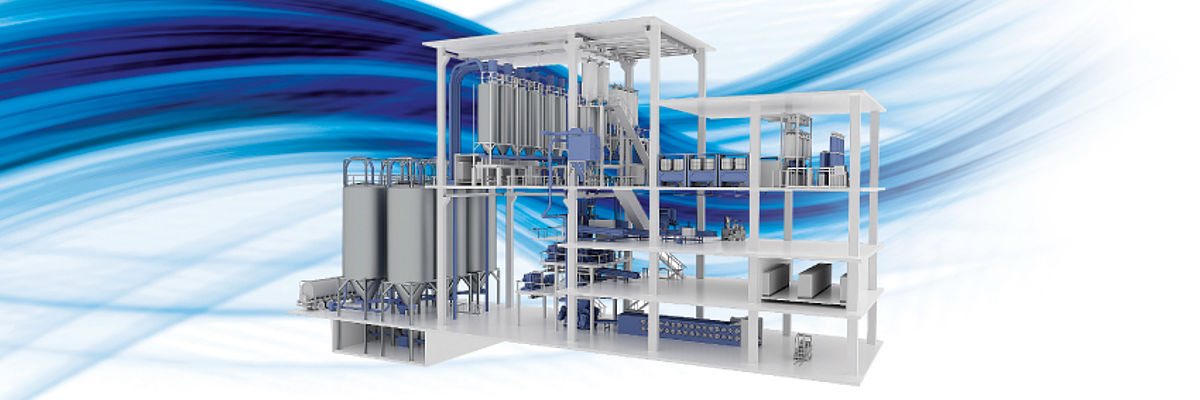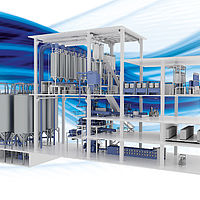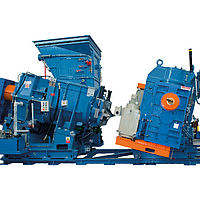Increasing energy efficiency is a major topic, and not only for our customers. At HF MIXING GROUP, we too are continuously putting our production operations and our processes on the energy-efficiency test stand. Since early 2015, we have been operating an energy and environmental management system according to DIN 50001 and DIN 14001. As a machinery constructor in whose brand DNA the principle of sustainability is securely anchored, we naturally support the Blue Competence Initiative of VDMA, the Plastics and Rubber Machinery Association. We will also apply for the RAL “Efficient use of energy in manufacturing industries” quality mark as soon as it has been established. Unlike existing certifications, the RAL quality mark assesses not only the energy efficiency of the processes, but also that of the individual products.
But what we do above all else is that what we’ve always done: provide the best possible support to our customers for their projects. Specifically with regard to energy efficiency, this means that we are working in high gear to optimise all aggregates of a mixer line relative to their energy efficiency. We’re working to build mixers that combine low energy consumption with high efficiency. And we didn’t just start yesterday.
Efficiency factor: drive system
Take the drive system, for example, where we have already accomplished a great deal. The drive of the mixer very strongly dominates the overall energy requirements of the mixing process, so its efficiency largely determines the energy savings potential of a mixing line. Not so long ago the direct current (DC) drive was the standard for mixer lines, but over the past decade we have equipped our mixers with modern alternating current (AC) drives. In combination with frequency converters, they deliver considerably more favourable efficiency curves for the specific requirements in the mixing room. This is because mixing demands very high outputs for only a short period of time, while requiring only low output from the motor during long phases of the process. In partial load operation, the AC motor works much more efficiently than its older brother. On average, it is reasonable to expect a 20% increase in efficiency when replacing direct current by alternating current. The effect of this on energy consumption is by no means negligible. In the tyre industry, a 320-litre DC-motor-driven interior mixer with a throughput of 3 t/h consumes 2.6 million kWh per year (assuming 6,000 h/yr operation), while the energy consumption of an interior mixer equipped with an AC motor can, due its greater efficiency, be reduced by 650,000 kWh per year. Expressed in euros, the operating costs for the drive are reduced – at an electricity price of 14 cents/kWh and an average power input of 900 kW – by 90,000 euros!
In order to achieve further efficiency increases, we have studied modular drive systems. These work – depending on the size of the interior mixer – with four to six motors, which drive the mixer rotors via a special gearbox. Since the drives of interior mixers operate under partial load conditions during many mixing phases, they often work very far from their optimum rated power and therefore inefficiently. The additional motors counteract this problem: by switching them off and on as necessary, it can be ensured that the motors are operated in the optimal efficiency range. This serves to optimise the efficiency of the drive by another 5%. For the 320-litre mixer from the example previously mentioned, this improvement in efficiency would mean additional savings of about 16,000 euros per year.
Savings potential: ram
Savings can also be achieved on elements other than the main drive, however. There is latent energy optimisation potential hidden in all other aggregates as well. Take the ram, for example. For about 15 years now, hydraulic ram pressure systems have been increasingly displacing the pneumatic systems widely used in the past. Not only are they quieter, but they also enable significantly faster ram motion while providing more precise and more reliable position control at the same time. In this way, they ensure constant process conditions – unlike the pneumatically driven ram, which can cause inconsistent mix quality due to pressure level variations.
When we compare the energy expenditures – and therefore the operating cost – of the two systems, the hydraulic ram is clearly superior. Operating an IM 320E mixer with a hydraulic ram results in up to 70% lower operating costs for the same number of hours – a considerable savings potential. A 320-litre interior mixer with a hydraulic ram requires half a million kWh per year less than an interior mixer equipped with a pneumatic ram. Expressed in euros, the operating costs for the ram are reduced – at an electricity price of 14 cents/kWh – by 70,000 euros.
he use of hydraulic feed systems offers many further advantages, however. With iRAM, the intelligent ram control system, process technicians and engineers have a powerful new process optimisation tool in their hands. Where the ram was once driven up and down pneumatically, iRAM permits displacement by predetermined distances.
This function and many other interesting ones can be used to exploit an extremely wide range of process engineering potentials. A broad range of practical experience shows that ram displacement control can be used to save cleaning steps and reduce ventilation steps. The result: mixing times reduced by up to 25%. Here, too, it is possible to save significant amounts of energy. Hydraulic feed systems and iRAM offer, beside the energy savings potentials described here, a large range of additional options. Not all rams are created equal.
Influence of the tempering aggregates
When we turn our attention to the periphery of the interior mixer, we see that tempering equipment can also be designed for greater energy efficiency. Under the normal operating conditions of the mixing process, which is characterised by continuously changing requirements, the pumps of the tempering aggregates run only very rarely at their optimal operating point. This means that whenever the tempering system is operating, the pump is always running at full volumetric capacity without speed regulation and accordingly at full power, although only part of that volumetric flow is needed. Without a need-dependent power adjustment, this results in unnecessarily high consumption of drive energy and therefore also higher operating costs.
Through the use of frequency-controlled pumps, the cooling can be adjusted to the process, thereby achieving additional energy savings. Tests on the system in the HF technical centre have shown that by controlling the speed control of the tempering units, the pump input power of the three TCU units – rotor / mixing chamber / ram – can be reduced by 50 to 75%. Expressed in energy costs, that amounts to about 8,000 euros per year.
Moreover, there is considerable savings potential in designing tempering aggregates with their specific purpose in mind. In order to do so, engineers must know not only the characteristic curve of the mixer component to be tempered (i.e. pressure loss as a function of flow rate) but also that of the tempering equipment (flow rate as a function of the back pressure to be overcome). The proper selection of pumps for each tempering circuit first requires a holistic analysis of those two relationships. Through individual examination of the mixer circuits, the size of a pump in a circuit can be reduced by up to 30% from the outset.
Twin-screw extruder
In the downstream aggregates underneath the interior mixer, the installed drives are also scrutinised. These machines are also installed with substantial drive power ratings – up to 300 kW for a Convex™ 12, for example. Outdated drive concepts such as direct current or hydraulic drives are often still in use here – the efficiency of which usually still offers considerable optimisation potential.
Extensive comparison testing in the field has shown that the screw geometry of the twin-screw extruders has a significant impact on the operating characteristics. In general, the conicity of the screw diameter results in a substantially higher capacity in the inlet area versus the discharge area of the screw. For this reason, a large proportion of the mixture is transferred “in the loop” (or backflow) from the front to the back of the extruder area. With a favourable screw arrangement, that amount of backflow (which is unnecessary for the functioning of the machine) can be diminished considerably and the energy consumption of the screw drive can be reduced by up to 33%.
Saving potential: dust seal
The area of the dust seals of an interior mixer offers attractive savings potentials, and not only with regard to energy efficiency. The load-dependent control of the compression forces of dust seals provides many additional benefits as well. With the recently developed “iXseal”, the HF MIXING GROUP offers an advanced concept aimed at achieving the following optimisation potentials:
- Reduction of lube oil consumption
- Minimisation of recycling costs
- Extension of dust seal service life
- Reduction of the load on the main drive
But how are these improvements achieved in the dust seal area? Extensive analyses at HF have shown that the rings of the dust seal need not be compressed against one another with full pressure in all process phases – as is the case today.
Moreover, this intelligent reduction of the hydraulic compression forces automatically enables a reduction of the lube oil supply between the seal rings. Shutting off the lube oil supply temporarily in this way can save significant quantities of oil.
A portion of the lube oil required for operation is not fed into the mixing chamber. The discharged oils must be collected and recycled. The associated costs often exceed the purchase price of the relevant oils several times over. So the reduction of the oils described here also minimises recycling expenses and makes the operation of mixers more environmentally sound.
“iXseal” reduces – as described above – the mean contact pressure between the rotating and fixed ring. This has a positive impact on the service life of the seal. Downtimes and maintenance frequency are reduced to a minimum.
In simplified form, the seals of an interior mixer are comparable to four disc brakes. If they are continuously subjected to high compression forces, that condition has an effect on the power consumption of the main drive. The intelligent reduction reduces the load on the seals, thereby also reducing the load on the drive of the rotors.
Our conclusion: a holistic view of the mixing process opens up opportunities for high savings potentials. Moreover, comprehensive automation of the complete mixer line system can eliminate further inefficiencies. Load spikes that occur when multiple lines are running load-intensive mixtures at the same time can be avoided in advance with an intelligent planning algorithm. Further potentials for energy savings become available to mixing room operators when the central automation system records and fully documents the energy consumed by each of the aggregates in the mixing room. This path will continue to be systematically followed by HF MIXING GROUP.




